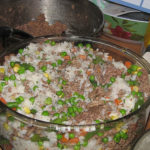The Mysteries of Pet Food Labels, with links to other articles
When selecting a pet food, it’s important to read the label. However, what’s on the front of the label is not nearly as important as what’s on the back. Words like “Natural”, “Organic”, and “Healthy” are not regulated and are not meaningful. The mysteries of pet food labels can cause confusion! Here are a few things that ARE meaningful:
Caloric Density
Obesity is one of the most common health issues in our pets today, and can shorten your pet’s life by several years. The best way to prevent it is to know your pet’s ideal weight and feed your pet for that weight. Your pet’s weight at 12-18 months is probably close to what they should weigh life-long, and your vet may have that recorded if you don’t remember. The back of your pet’s food should list kcal/cup or kcal/can or some such measurement. Calories with a capital “C” and kilocalories or kcals are the same thing. This measurement is a good way to compare food economy. A higher quality food often is denser calorie-wise so you’ll feed less than a cheaper food. We usually recommend feeding your pet according to their ideal weight rather than their actual weight. If you are interested in an exact recommended number of calories per day for your pet, we can calculate that for you. Just email Doctor Leonard or ask our tech Kyla when you come in!
AAFCO Statement
This statement will be somewhere on the bag of any balanced diet that has met certain standards. It will state something like “This food meets the AAFCO requirements for maintenance of adult dogs”. It may also include “for growth of puppies/kittens” or “for the growth of large-breed dogs” or “for all life-stages”. Make sure the food you are selecting meets these requirements for your pet’s age and breed. AAFCO requirements mean the food has at least the minimum amount of important nutrients for the listed life-stages. Some boutique type foods, or “ratio” types of raw foods will not have this statement and are not a complete and balanced diet by themselves. We recommend only feeding foods that meet these standards of balance, or a home-made diet that has been determined by nutritional calculations to contain all nutrients needed to meet this standard. A “do-it-yourself” diet, ratio diet, “balance-over-time” diet and many recipes found online are not nutritionally adequate and may cause serious health problems in time. For more information, see this newsletter:
https://www.wholehealthpetcenter.com/the-importance-of-a-balanced-diet/
Ingredients
This is one of the more important parts of the label to read. There are a few tricky things you should understand when reading this. First, ingredients are listed by WEIGHT. Heavier ingredients (like meat) will likely be listed before lighter ones (like chicken meal). “Meals” are powdery light-weight ingredients. A food with a “meal” listed second after a meat may well be 50% or more “meal” by percentage. “Meal” is a highly heat- and pressure-processed ingredient that may contribute to inflammation in the body.
Second, ingredients listed lower than salt are present in very small amounts. It’s fine to see vitamins and minerals below salt, but don’t be fooled by vegetables and fruits listed this low on the list. Those are not present in high enough amounts to really be counted as fruit or vegetable servings. Imagine if your plate contained less spinach than salt!
Third, ingredients on the upper third or so of this list should sound more like a grocery list than a chemistry experiment. Vitamins and minerals will appear near the bottom of the list, but the top ingredients should sound like things you can buy in the grocery store. Things like corn gluten meal and chicken byproduct meal and animal digest should not be fed to pets.
Fourth, it’s probably best to avoid foods with peas, pea protein, chickpeas, and other legumes high on the ingredient list. As discussed in previous newsletters,
and
https://www.wholehealthpetcenter.com/connection-grain-free-diets-heart-disease-dogs/ )
there may be some correlation between these ingredients in grain-free diets and heart disease in some pets. This is mainly an issue in grain-free dog foods. It’s OK to feed cats grain-free, and actually ideal for them, but it’s still best to find diets that don’t use peas or the like as a substitute for grains. Dogs can digest grains, but it’s best that they be below the first two spots on the ingredient list. We also like to avoid wheat, corn, and soy due to the high levels of Roundup these crops are exposed to. OK grains include barley, oats, and rice. Potatoes and Sweet potatoes may also show up as carb sources and are fine in dog foods. Cat food is optimally less than 10-15% carbs.
If your pet has health concerns with skin or gut problems, a diet change may help. We recommend first scheduling a physical and Chinese medical exam and a nutritional consult. We may also want to do bloodwork or other tests to determine the best food choices. Diet changes can control or even cure many chronic issues.
For more information, see our additional newsletter, Pet Food Selection Tips, found here: https://www.wholehealthpetcenter.com/pet-food-selection-tips/
Also, for information on introducing new foods to your pets, read this: https://www.wholehealthpetcenter.com/how-to-change-your-pets-diet/
Hopefully, this article will clear up some of the Mysteries of Pet Food Labels for you!









